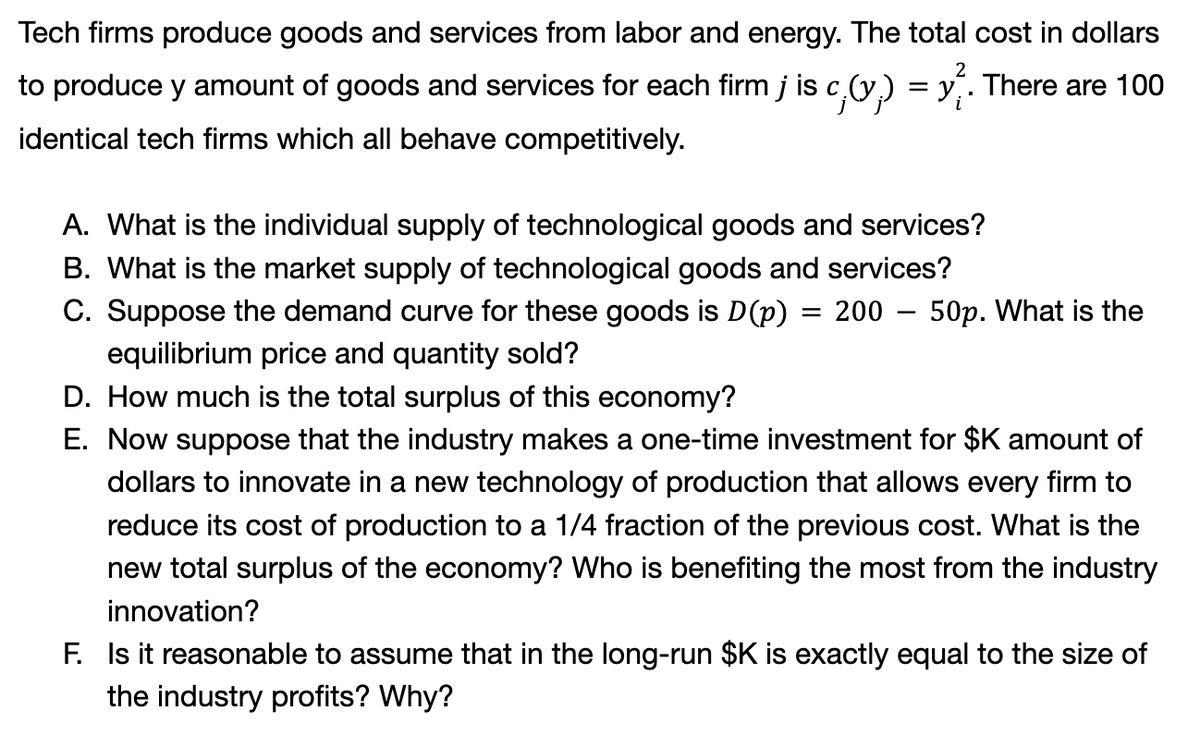ech firms produce goods and services from labor and energy. The total cost in dollars to produce y amount of goods and services for each firm j is cj(yj) = yi2. There are 100 identical tech firms which all behave competitively. What is the individual supply of technological goods and services? What is the market supply of technological goods and services? Suppose the demand curve for these goods is D(p)=200-50p. What is the equilibrium price and quantity sold?
ech firms produce goods and services from labor and energy. The total cost in dollars to produce y amount of goods and services for each firm j is cj(yj) = yi2. There are 100 identical tech firms which all behave competitively. What is the individual supply of technological goods and services? What is the market supply of technological goods and services? Suppose the demand curve for these goods is D(p)=200-50p. What is the equilibrium price and quantity sold?
Managerial Economics: A Problem Solving Approach
5th Edition
ISBN:9781337106665
Author:Luke M. Froeb, Brian T. McCann, Michael R. Ward, Mike Shor
Publisher:Luke M. Froeb, Brian T. McCann, Michael R. Ward, Mike Shor
Chapter5: Investment Decisions: Look Ahead And Reason Back
Section: Chapter Questions
Problem 5.6IP
Related questions
Question
(This is a single question with five parts to the answer. I would appreciate help with all five parts if possible. Image screenshot of the original question with the formulas more easily readable than can be identified here is attached)
Tech firms produce goods and services from labor and energy. The total cost in dollars to produce y amount of goods and services for each firm j is cj(yj) = yi2. There are 100 identical tech firms which all behave competitively.
- What is the individual supply of technological goods and services?
- What is the market supply of technological goods and services?
- Suppose the demand curve for these goods is D(p)=200-50p. What is the
equilibrium price and quantity sold? - How much is the total surplus of this economy?
- Now suppose that the industry makes a one-time investment for $K amount of dollars to innovate in a new technology of production that allows every firm to reduce its cost of production to a 1/4 fraction of the previous cost. What is the new total surplus of the economy? Who is benefiting the most from the industry innovation?
- Is it reasonable to assume that in the long-run $K is exactly equal to the size of the industry profits? why?

Transcribed Image Text:2
Tech firms produce goods and services from labor and energy. The total cost in dollars
to produce y amount of goods and services for each firm j is c,(v.) = y. There are 100
identical tech firms which all behave competitively.
A. What is the individual supply of technological goods and services?
B. What is the market supply of technological goods and services?
C. Suppose the demand curve for these goods is D(p) = 200
equilibrium price and quantity sold?
D. How much is the total surplus of this economy?
E. Now suppose that the industry makes a one-time investment for $K amount of
dollars to innovate in a new technology of production that allows every firm to
reduce its cost of production to a 1/4 fraction of the previous cost. What is the
new total surplus of the economy? Who is benefiting the most from the industry
innovation?
50p. What is the
F. Is it reasonable to assume that in the long-run $K is exactly equal to the size of
the industry profits? Why?
Expert Solution
This question has been solved!
Explore an expertly crafted, step-by-step solution for a thorough understanding of key concepts.
Step by step
Solved in 2 steps

Knowledge Booster
Learn more about
Need a deep-dive on the concept behind this application? Look no further. Learn more about this topic, economics and related others by exploring similar questions and additional content below.Recommended textbooks for you

Managerial Economics: A Problem Solving Approach
Economics
ISBN:
9781337106665
Author:
Luke M. Froeb, Brian T. McCann, Michael R. Ward, Mike Shor
Publisher:
Cengage Learning

Managerial Economics: A Problem Solving Approach
Economics
ISBN:
9781337106665
Author:
Luke M. Froeb, Brian T. McCann, Michael R. Ward, Mike Shor
Publisher:
Cengage Learning